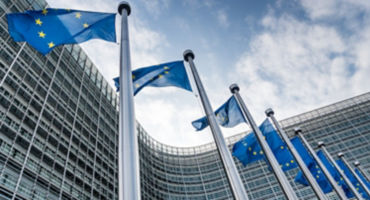- Macro Strategist
Skip to main content
- Funds
- Insights
- Capabilities
- About Us
- My Account
The views expressed are those of the author at the time of writing. Other teams may hold different views and make different investment decisions. The value of your investment may become worth more or less than at the time of original investment. While any third-party data used is considered reliable, its accuracy is not guaranteed. For professional, institutional, or accredited investors only.
I believe that Europe is experiencing a regime change driven by a powerful combination of global and Europe-specific factors that could have significant implications for its financial and equity markets. In summary, I believe that:
Rising geopolitical tensions, trade wars and onshoring are major headwinds to globalisation. As geopolitical tensions and trade restrictions continue to increase, the share of international trade in the global economy could start to fall. Europe has been a major beneficiary of globalisation as its economies are among the most open in the world. International expansion and optimisation of supply chains were major drivers of profitability for European multinationals, especially in the aftermath of the global financial crisis (GFC), when European domestic demand was unusually depressed.
Now, however, Europe looks particularly vulnerable. For example, Germany’s current economic malaise can be explained to a large extent by its decade-long policy of favouring exports over domestic demand. As European companies adapt to this new, more fragmented environment, being an internationally orientated company may no longer be such a positive.
Investment implications — In aggregate, I expect domestically focused sectors and small caps to fare better than the major exporters, and periphery markets to continue outperforming their core counterparts. A second Trump term is likely accelerating this shift.
In the decade after the financial crisis, central banks were able to keep monetary policy unusually loose for a given level of growth as inflation was virtually non-existent. Risk assets such as equities massively benefited from this continued policy stimulus, especially in the US.
However, I believe this is changing. Trends such as slowing globalisation, greater political intervention, continued fiscal expansion and global ageing are likely to lead to intrinsically higher inflation compared to the post-GFC period. At the same time, it is possible that Europe will feel the deflationary impact from AI later than the US (as regulation might slow the adoption of AI in Europe).
While European central banks have recently started to cut rates to support faltering growth, the structural shift in inflation means that any further rate decisions will have to be weighed up against Europe’s deteriorating growth and inflation trade-off. China exporting its overcapacity could provide a partial deflationary offset, but, on balance, I believe that inflation and rates will remain structurally higher.
Investment implications — The structural return to positive rates should be supportive for European equities relative to other regions but with certain areas benefiting more than others:
For much of the post-GFC period, Europe focused on austerity measures, which acted as a major drag on domestic demand. Slowly, however, there is growing recognition that more coordinated fiscal spending is needed across a range of issues, including the energy transition, defence, deindustrialisation and digitalisation. Some examples of this ongoing shift include:
In contrast to the US, European politicians have rarely used “national security” as a driver of policy. However, supply chain issues during COVID, the energy crisis, Russia’s invasion of Ukraine and rising geopolitical tensions mean this is changing. Energy independence, robust defence capabilities, resilience of supply chains and access to key resources are now important policy goals for European and national policymakers. These new priorities are likely to translate into more interventionist policies, with major changes to subsidies and regulatory support for key industries.
Investment implications — This willingness to use fiscal spending along with targeted political and regulatory intervention will create winners and losers. Defence companies, telecom operators (the digitalisation theme) and electricity network operators (the energy transition) are potential beneficiaries of this trend. Defence companies are likely to be the most immediate winners, given the urgency of more NATO spending and accelerating efforts by the EU to strengthen the European defence industry.
Europe’s population is ageing rapidly, with Europe’s workforce expected to shrink over the coming years. This helps to explain why we see labour hoarding and strong wage growth despite a weak macro backdrop.
Investment implications — One key implication of the shift in demographics is increased investment in automation, efficiency and learning, which could benefit select companies within the capital goods and the software space.
While Europe has had very little exposure to the current tech super cycle, a number of European companies are market leaders in important parts of the energy transition. This transition is likely to propel what could be the next super cycle, driven by significant fiscal and regulatory tailwinds.
Investment implications — According to some estimates, 42 companies in Europe, representing around 15% of European stock markets’ cap, are leaders in the fields of green-related energy and sustainability. However, not all companies active in the wider energy-transition space are protected by high barriers to entry; for instance, companies supplying heat pumps and solar panels have proven to be vulnerable. This divergence between winners and losers should create a range of opportunities for active investors.
Europe’s regime change is unlikely to be a straightforward journey, creating risks but also outstanding opportunities for active investors. With that in mind, I would advocate a barbell strategy with the core focused on domestic cyclicality (companies exposed to European consumers, construction and banks) and earnings resilience, along with select exposure to the likely winners of Europe’s interventionist approach in pursuit of national security. Longer term, I would also encourage investors to keep a close eye on potential winners and losers of the energy transition super cycle and other key trends such as demographics that are reshaping Europe’s investment landscape.
Expert

False signals? A macro investing playbook
Continue readingThe long-term rewards of a contrarian approach to European equities
Continue readingHow a changing Europe is reshaping credit markets
Continue readingIntegrating end-beneficiary insights into impact investing: Microfinance case study
Continue readingStill opportunities in European equities? Positioning is key
Continue readingEurope: Fertile ground for long/short alpha opportunities
Continue readingURL References
Related Insights
Stay up to date with the latest market insights and our point of view.

Asset Allocation Outlook
How to evolve your portfolio for the latest market conditions? Explore the latest monthly snapshot of Wellington Solutions' asset class views.

False signals? A macro investing playbook
Portfolio Manager Arancha Cano shares her insights on interpreting potentially conflicting and unreliable data signals as investors navigate an increasingly uncertain market environment.

The long-term rewards of a contrarian approach to European equities
Portfolio Manager Tom Horsey and Investment Director Thomas Kramer explain why viewing European equities through a contrarian lens could help investors to uncover long-term opportunities in a rapidly evolving Europe.

How a changing Europe is reshaping credit markets
Portfolio Managers Derek Hynes and Konstantin Leidman explore how a changing Europe is reshaping the region's credit markets and identify key takeaways for investors.

Integrating end-beneficiary insights into impact investing: Microfinance case study
Louisa Boltz and Oyin Oduya join with Pranav Sridhar from 60 Decibels to examine best practices for bringing end-beneficiary insights into impact investing.

Still opportunities in European equities? Positioning is key
Macro Strategist Nicolas Wylenzek revisits the case for European equities and discusses why positioning can help optimise exposure to Europe’s accelerating regime change.

Europe: Fertile ground for long/short alpha opportunities
Dirk Enderlein, Eoin O’Callaghan, and Boris Kergall, explore European equity opportunities from a long/short perspective against a backdrop of volatile markets and structural growth shifts.

Europe: a good hunting ground for high yield?
With attractive yields and a low duration profile, high yield can present potentially compelling opportunities for investors, despite the continued volatility.

Fiscal versus tariffs: what wins out for Europe?
Just as investors were starting to explore the potential for growth in Europe, Trump’s tariffs landed. To what extent is the case for Europe still intact?

Sacrificing stocks on the altar of trade
Brij Khurana discusses the Trump administration's new stance on trade and its impact on the US economy, global markets and asset prices.

The changing face of Europe: regime change gathers pace
Macro Strategist Nicolas Wylenzek explores the drivers of Europe’s accelerating regime change and its impact on European equity markets and potential areas of opportunity.
URL References
Related Insights